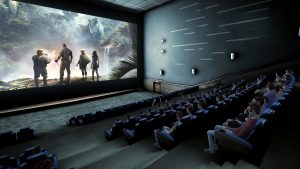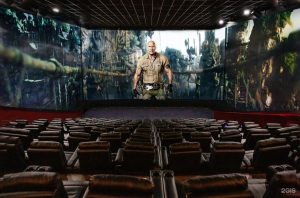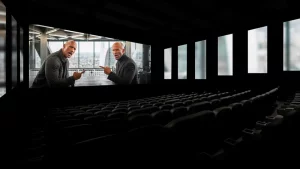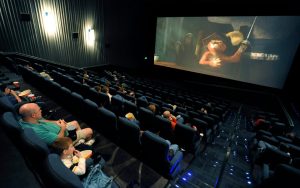Introduction
The world of cinema has always been one of innovation, constantly striving to push the boundaries of storytelling and audience engagement. From the early days of silent films to the advent of color and sound, each technological leap has brought us closer to more vivid and compelling cinematic experiences. Today, we stand on the cusp of another revolution in movie watching: immersive theaters. These cutting-edge venues are not just about watching a film; they are about experiencing it in a way that engages all the senses. This article delves into how immersive theaters are redefining movie watching, exploring the technology, design, and future trends that make this evolution possible.
The Evolution of Movie Watching

-
Early Beginnings
The history of movie watching is a fascinating journey. The first public screening of a film took place in 1895, and since then, the medium has evolved in leaps and bounds. Early theaters were simple venues with wooden chairs and a single screen. The focus was on the film itself, with little attention paid to the environment in which it was shown.
-
The Advent of Sound and Color
The introduction of sound in the late 1920s and color in the 1930s were significant milestones. These innovations made films more engaging and lifelike, drawing audiences deeper into the story. Theaters began to upgrade their facilities, offering more comfortable seating and better acoustics to enhance the viewing experience.
-
The Multiplex Era
The 1960s and 70s saw the rise of multiplex theaters, which offered multiple screens and a variety of films under one roof. This was a significant shift, as it allowed for greater choice and convenience for moviegoers. However, the core experience of watching a film remained largely the same.
The Birth of Immersive Theaters

-
What Are Immersive Theaters?
Immersive theaters represent the next frontier in movie watching. These venues go beyond traditional cinema by incorporating advanced technologies and innovative design elements to create a fully immersive experience. The goal is to make the audience feel as though they are part of the film, rather than just passive observers.
-
Key Technologies
- 3D and 4D Experiences
3D technology has been around for several years, but immersive theaters take it to the next level with 4D experiences. These include motion seats, wind, rain, and even scents that correspond to the onscreen action. - Virtual Reality (VR)
Some immersive theaters are experimenting with VR headsets, allowing viewers to step into the film’s world. This technology offers a 360-degree field of view, making the experience incredibly lifelike. - Augmented Reality (AR)
AR overlays digital elements onto the real world, creating a blended experience. In immersive theaters, AR can be used to enhance the environment, making it feel like an extension of the film. - High Definition Audio and Visuals
Cutting-edge sound systems and ultra-high-definition screens ensure that every detail is crystal clear. Dolby Atmos and IMAX are examples of technologies that provide an unparalleled audiovisual experience.
The Design of Immersive Theaters

-
Architectural Innovations
The design of immersive theaters is a crucial element in creating a compelling experience. Unlike traditional theaters, which focus primarily on screen size and seating capacity, immersive theaters pay attention to every aspect of the environment.
-
Seating Arrangements
Seats are often arranged in a way that maximizes the field of view and ensures that every audience member has an optimal experience. Reclining seats, motion chairs, and even beds are becoming common features.
-
Acoustic Engineering
Advanced acoustic engineering ensures that sound is evenly distributed throughout the theater. This creates a more immersive audio experience, making viewers feel as though they are part of the action.
-
Lighting and Ambiance
Dynamic lighting systems can change the color and intensity of the theater’s lights to match the mood of the film. This adds another layer of immersion, enhancing the emotional impact of key scenes.
The Impact on Movie Watching

- Enhanced Engagement
One of the most significant benefits of immersive theaters is the level of engagement they offer. Traditional movie watching can sometimes feel passive, but immersive theaters make the audience an active participant in the experience. This heightened engagement can lead to a deeper emotional connection with the film.
- Broader Appeal
Immersive theaters have the potential to attract a broader audience. People who may not be interested in traditional cinema might be drawn to the unique experiences offered by these venues. This could lead to increased ticket sales and a revitalization of the cinema industry.
- New Storytelling Possibilities
The technologies used in immersive theaters open up new possibilities for filmmakers. Directors can experiment with different formats and techniques, knowing that their work will be presented in a way that maximizes its impact. This could lead to a new wave of innovative films that push the boundaries of storytelling.
Challenges and Considerations

-
Cost
One of the primary challenges facing immersive theaters is the cost. The advanced technologies and specialized design elements required for these venues can be expensive to implement. This may limit their accessibility, at least in the short term.
-
Technical Issues
As with any new technology, there are potential technical issues to consider. VR headsets, for example, can cause motion sickness in some users. Ensuring that the technology is reliable and comfortable for all audience members is crucial for the success of immersive theaters.
-
Content Availability
Another consideration is the availability of content. While some filmmakers are embracing the possibilities offered by immersive theaters, others may be slower to adapt. Ensuring a steady stream of high-quality content will be essential for the long-term success of these venues.
The Future of Immersive Theaters

-
Continued Innovation
The future of immersive theaters looks bright, with continued innovation on the horizon. Advances in technology will likely make these experiences even more compelling and accessible. For example, improvements in VR and AR could lead to more seamless and realistic experiences.
-
Expansion and Accessibility
As the technology becomes more affordable, we can expect to see immersive theaters in more locations. This increased accessibility will allow more people to experience the magic of immersive movie watching, further solidifying its place in the cinema landscape.
-
Integration with Other Media
Immersive theaters may also begin to integrate with other forms of media. For example, video games and live performances could be adapted for immersive theater experiences, offering new and exciting ways to engage with different types of content.
Analysis Table: Immersive vs. Traditional Theaters
| Feature | Immersive Theaters | Traditional Theaters |
| Audience Engagement | High (active participation) | Low (passive observation) |
| Technology | Advanced (AR, VR, 3D sound) | Standard (2D/3D visuals, basic sound systems) |
| Interaction Level | High (physical and emotional engagement) | Minimal (limited to reactions) |
| Storytelling Format | Non-linear, interactive options | Linear, fixed narratives |
| Social Experience | High (shared interactions, communal experiences) | Moderate (audience reactions) |
| Accessibility | Limited (higher costs, potential discomfort) | Broad (widely accepted format) |
Comparative Table: Audience Preferences
| Audience Type | Immersive Theaters | Traditional Theaters |
| Age Group | Younger audiences (18-35) | All age groups |
| Experience Preference | Seeking unique, interactive experiences | Preference for classic viewing |
| Engagement Level | High engagement sought | Low engagement expected |
| Willingness to Pay | Higher willingness for immersive content | Price-sensitive, traditional pricing |
| Social Interaction | Favor communal experiences | Accept social experiences |
Conclusion
Immersive theaters are redefining movie watching by offering experiences that engage all the senses. Through advanced technologies like 4D, VR, and AR, and innovative design elements, these venues are creating a new standard for cinematic experiences. While there are challenges to overcome, the potential benefits are immense. As we look to the future, it is clear that immersive theaters will play a significant role in the evolution of cinema, offering audiences new and exciting ways to experience the magic of film.




